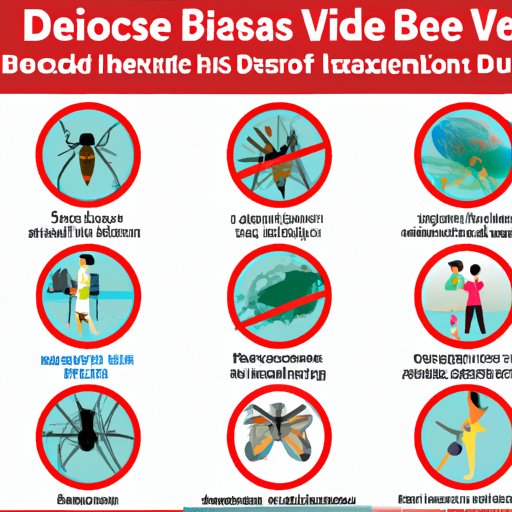
I. Introduction
Vector diseases, also known as vector-borne diseases, are caused by pathogens, such as bacteria and viruses, that are transmitted to humans through the bite of a vector, which can be a mosquito, tick, or flea. These diseases are crucial to understand because they can have severe consequences on human health, from mild flu-like symptoms to life-threatening illnesses. This article will provide a comprehensive guide to vector diseases, including an explanation of what vector diseases are, how they are transmitted, and the steps you can take to stay safe.
II. Everything You Need to Know About Vector Diseases: Understanding the Basics
Vector diseases are infectious diseases that are transferred to humans from animal hosts through the bite of a vector. Mosquitoes, ticks, fleas are the most common carriers of these diseases. They get infected by biting other animals that carry the pathogens, and then transmit it to the next host they bite.
Vector-borne illnesses can be classified based on the types of pathogens causing them, including viruses, bacteria, and parasites. Common pathogens that cause vector diseases are West Nile virus, Malaria, Lyme disease, and Zika virus. Symptoms may range from mild, flu-like symptoms to severe, life-threatening illnesses, depending on the underlying pathogen.
III. Vectors and the Diseases They Spread: A Comprehensive Guide
The most common vector-borne illnesses are Lyme disease, Malaria, Dengue fever, and Zika virus disease. Ticks spread Lyme disease, while mosquitoes spread Malaria, Dengue fever, and Zika virus.
Lyme disease causes a severe rash around the affected area, body aches, and joint pain. It can also impact the heart and nervous system if left untreated. Malaria patients usually feel fatigue, fever, and muscle pain. Dengue fever and Zika virus disease both have symptoms like fever, joint pain, rashes, and headache. Pregnant women should be cautious because Zika virus can cause severe defects in fetuses.
The diagnosis process for vector diseases is different for each pathogen. Mosquito-borne diseases can be monitored initially by clinical symptoms. Still, specific diagnostic tests, including genetic tests, antigen-antibody tests, or virus isolation techniques, are necessary to confirm the presence of the pathogen. In contrast, ticks require careful examination as they are small and hard to detect generally.
IV. Preventing Vector-borne Illnesses: Tips and Strategies
Preventing vector-borne illnesses mainly involves avoiding bites and reducing the population of vectors in the environment. Wearing long-sleeved shirts and long pants while you are outside and applying appropriate mosquito repellent to areas of the body exposed. Natural insect repellents include citronella oil, peppermint oil, or lemon eucalyptus oil. You may also eliminate potential breeding sites, including standing water, by emptying any containers outside that contain it.
V. The Most Common Vector Diseases and How to Protect Yourself
The most common vector-borne illnesses that threaten human health include Lyme disease, Malaria, Dengue fever, and Zika Virus disease. Using prevention methods such as wearing protective clothing, using insect repellents, and maintaining a safe and clean environment, the chances of contracting these diseases can be reduced. If you exhibit symptoms such as rash, fever, fatigue, or a combination of these symptoms, it is essential to seek immediate medical attention.
VI. Exploring the Link Between Climate Change and Vector-borne Diseases
Climate change causes changes in ecosystems, affecting animal and plant life in these areas. One impact of climate change has been the increase in the population of vectors, which could lead to an increase in the spread of vector-borne diseases. Moreover, increased temperatures caused by climate change can alter mosquito behavior, making it more likely for mosquitoes to bite humans. By destroying potential breeding sites, controlling vegetation, and preventing exposure of humans to disease vectors to stop the spread of these diseases.
VII. Conclusion
Vector-borne illnesses pose a significant threat to individuals exposed to them. This article provided a comprehensive guide to vector diseases, including information on how they are transmitted, how to recognize symptoms, and ways to reduce the risk of contracting them. Vector-borne diseases can have severe consequences on human health, leading to short-term and long-term effects. Therefore, it is necessary to take necessary precautions to prevent the spread of vector-borne diseases.




